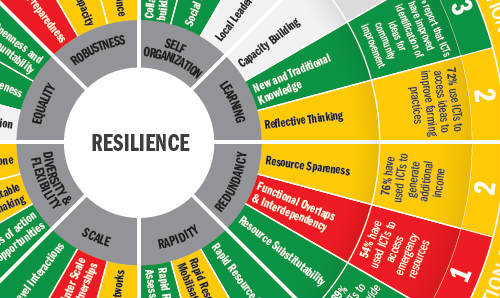Resilience Assessment Benchmarking and Impact Toolkit (RABIT)
As the 21st century proceeds, countries – particularly developing countries – will face a growing series of short-term shocks (economic crises, climate events, violent attacks, health epidemics, etc) and long-term trends (climate change, migration, economic restructuring, new technologies, etc). In abstract terms, we know the solution: countries must become more resilient.
That is because resilience is defined as the ability of vulnerable systems – countries, regions, communities, value chains, organisations – to withstand, recover from, adapt to, and potentially transform amid change and uncertainty. Resilience will therefore play a crucial role in the achievement of development outcomes. It provides a holistic and long-term approach that is rising up the development agenda.
That is the theory. The challenge arises in practice: there are few credible guides that activists and researchers can follow which explain what resilience is, how to apply resilience metrics, and how to use those metrics to shape action. This was the impetus behind the creation of RABIT: the Resilience Assessment Benchmarking and Impact Toolkit. This project involved the creation of RABIT and then its field-testing in two locations: a low-income urban community in Costa Rica, and a low-income rural community in Uganda.
This project is being carried out by Professor Richard Heeks and visiting researcher, Dr Angelica Ospina. It is in collaboration with in collaboration with Lutheran World Relief (Uganda) and Sula Batsu (Costa Rica). It is funded by Lutheran World Relief and The University of Manchester.
Academic outputs
- Richard Heeks and Angelica V. Ospina, 2015, ‘Analysing urban community informatics from a resilience perspective’, The Journal of Community Informatics, Vol 11, No 1 (2015)
- Richard Heeks and Angelica V Ospina, ‘Conceptualising the link between information systems and resilience: A developing country field study’, Information Systems Journal (2018)
Findings
The project provided a proof-of-concept for RABIT in two different contexts, demonstrating that its resilience model – based on understanding resilience as a system property of nine attributes – was appropriate for application in development environments. It is an appropriate tool for measuring community resilience, for visualising resilience, and for planning future resilience interventions.
Its main contribution has been summed up as “3Ps”:
- Prioritisation: visualisation and identification of priorities for future resilience interventions, including those based around information and communication technologies (ICTs)
- Participation: ensuring the involvement of community members in resilience measurement and prioritisation.
- Progression: providing a quantitative foundation for resilience measurement, enabling measurement of the impact of interventions on resilience over time.
Impacts
The project was able to measure and visualise two different aspects of resilience:
- first, the overall resilience of the two communities (in the Costa Rican capital, San Jose; and in the Mount Elgon coffee farming region of Uganda)
- second, the “e-resilience” of these communities; that is, the contribution that ICTs were making to resilience.
As a result, the project was able to develop a priority plan for strengthening both the resilience and the e-resilience of each community. These were visualised in a number of ways; for example via the e-resilience wheel:

